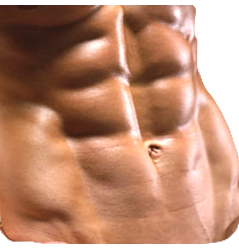Six Pack Abs, or Why Hard Muscle is Bad
Our bodies reflect our feelings about ourselves as we can take on many compensatory patterns due to the way we look and feel.
We tuck our pelvis because we think our butt is too big, we hunch our shoulders to hide our breasts or lean over constantly because we feel too tall.
There are many more that could be added to this list but one that is really fascinating is the desire for six pack abs and hard muscle.
For many, the sit up, or crunch, is worshipped as an express train to beauty.
The rectus abdominis is a pair of muscles connecting the pubic bone to the sternum and three ribs at the base of the ribcage.
When we refer to a “six pack” we are talking about the rectus abdominis.
The specific look of a six pack happens for a reason as the body has interesting and different ways of compensating for dilemmas of length and space.
The length of the span between the pelvis and the ribcage is really too long for one muscle to provide support without any bones around to help out.
To allow this muscle to do its job we have tendinous insertions that fall between what are actually ten small muscles (5 on either side).
We actually build ten packs of hard muscle but we tend to see six of them.
The look of the six pack abs is formed when we make these individual muscles big enough so that they essentially pop out from the tendons that surround them.
Muscles are designed to stretch while tendons are not.
How Do Muscles Work?
While some people might think this looks good, and plenty do, I’d like to take a moment to explain the nature of what is happening when you build a body with hard muscle.
Skeletal muscle is made up of thousands of cylindrical muscle fibers often running through the entire length or breadth of a muscle.
The fibers are bound together into muscle by connective tissue with blood vessels and nerves running through them.
Blood flows through muscles, passing through and around the endless number of fibers that make up an individual muscle.
The way we build muscle mass is by creating micro tears in the muscle fibers and as they heal or repair the body overcompensates in a way, replacing the damaged tissue and adding more, for protection against further damage.
As we continue to build muscle, the fibers need to have somewhere to go and they begin to lay down on top of one another.
Hard Muscle Isn’t Neccessarily Healthy
As more mass develops the layering becomes denser. At a certain point, your six-pack abs will have formed but there will be very little room between the fibers as the hard muscle continues to develop.
All this while the tendons between the muscles stay exactly as they are.
And issues can arise when our muscles are too large and hard. The density of muscle fibers will begin to inhibit the flow of blood and oxygen through the muscle, which can lead to trouble down the road.
There is nothing wrong in making the choice to build hard muscles and developing six pack abs.
But it is important that we have a clear understanding of the possible consequences.

